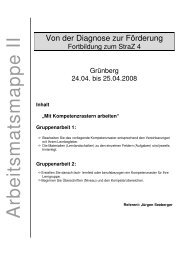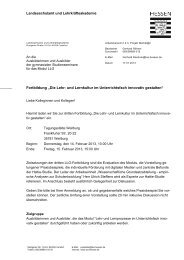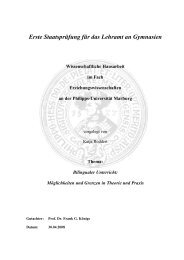PROFILING EUROPEAN CLIL CLASSROOMS
PROFILING EUROPEAN CLIL CLASSROOMS
PROFILING EUROPEAN CLIL CLASSROOMS
You also want an ePaper? Increase the reach of your titles
YUMPU automatically turns print PDFs into web optimized ePapers that Google loves.
LANTIX<br />
Develop Oral Communication Skills<br />
This is a very common aim within <strong>CLIL</strong> where one part of overall language competence<br />
is given special importance. It is often based on the problem of having knowledge of<br />
a language, but not being able to actually use the language in real-life situations.<br />
Communication channels from face-to-face to e-mail have become increasingly<br />
important in Europe as mobility, both virtual and physical, has increased. Much<br />
communication, particularly in written form through information and communication<br />
technology modes, requires the ability to use oral language effectively.<br />
Key <strong>CLIL</strong> Features<br />
➔<br />
➔<br />
➔<br />
➔<br />
➔<br />
Providing opportunities for students to speak demands less ‘linguistic’ skill on the<br />
part of a teacher and this suits certain non-language specialists<br />
Can be particularly suitable for starting <strong>CLIL</strong> with the development of reading &<br />
writing skills following afterwards<br />
High exposure <strong>CLIL</strong> for younger learners should involve teachers who offer good<br />
models of the target language<br />
The practising of oral skills can be done in a ‘utilitarian’ way – that is to provide<br />
opportunities to use the language ‘as a tool’. In such cases, even if desirable it is<br />
not necessary for a teacher to have native-like competence in the target language<br />
When <strong>CLIL</strong> is used for this focus it is essential that the learners themselves have<br />
opportunities to communicate in the target language in the classroom. This means<br />
that methods have to be used which lead to a high degree of interaction within the<br />
class<br />
Examples<br />
•<br />
•<br />
Where young learners are exposed to the target language through short ‘language<br />
showers’ by which listening, speaking, or even singing in the target language is<br />
introduced in very short sessions over a longer period of time. One objective is to<br />
introduce the sounds of the language at an early age<br />
A course that deliberately focuses on oral development in the first phase, which might<br />
be followed by focus on reading and writing skills<br />
It builds the ability to learn other languages; to move beyond bilingualism, to<br />
develop more languages. This capacity is more developed in the students who’ve<br />
studied in two languages (InterTalk)<br />
35
















